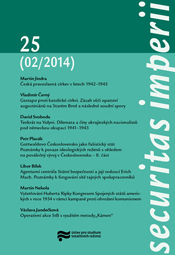Gottwaldovo Československo jako fašistický stát Poznámky k povaze ideologických režimů s ohledem na poválečný vývoj v Československu – II. část
Gottwald’s Czechoslovakia as a fascist state Notes on the nature of ideological regimes with regard to post-war developments in Czechoslovakia – part II.
Author(s): Petr PlacákSubject(s): Government/Political systems, WW II and following years (1940 - 1949), History of Communism, Fascism, Nazism and WW II
Published by: Ústav pro studium totalitních režimů
Keywords: Klement Gottwald;post-war Czechoslovakia; ideological regimes;comparation
Summary/Abstract: The study is a loose continuation of a text by the same author published – under the name “Fascism as a radical people´s revolution. Notes on the nature of ideological regimes with regard to post-war developments in Czechoslovakia, part I” – in No. 22/2013 of this journal. The text draws attention to the unsustainable dominant mainstream interpretation of the political system of the so called Third Czechoslovak Republic (May 1945 – February 1948), including ignoring of its fascist character by both communist and current post-communist Czech historiography. The author declares that this period of the 20th century Czech history did not aim at restoration of the inter-war parliamentary or liberal democracy since the so called “National front” regime under the control of the Communist Party was deliberately aiming at revolutionary establishment of a “society of a totally new quality” in which the existing (i.e. pre-war) political, economic, civil and cultural values were gradually eliminated. Among the main reasons of this process and of the communist leading position in it, which was by no means based on reality taking the traditional electoral potential of the communists (10%) into account, are listed: 1) Shock caused by the German Nazism and a sense of social danger; 2) Liberation of the Czech lands from the East by the Red Army; 3) Suicidal policy of the Czech government in exile in London led by E. Beneš, which promoted international cooperation with the Soviet Union as the best safety guarantee of the renewed state. The sub-chapters give evidence and provide analysis of propagandistic tools applied by the National Front, or the communists, which were used as a camouflage of the real aims and justification for a far-reaching social change – the use of the terms fascism and anti-fascism, anti-Semitism, national treason and national purge – as well as stigmatizing of members of non-Slavic nationalities, i.e. Germans and Hungarians living in Czechoslovakia as collectively guilty of the tragic war happenings. The Czechoslovak regime of the National Front “legitimized” and established itself in a similar way like the Italian fascist movement after WWI – it profited from the preceding political and social crisis, defined itself against the inter-war liberal democracy but in fact was a continuation of the Nazi protectorate (which is now considered a taboo in historiography). The ideological backbone of the fascism of the National Front, or the communists, is evidenced by the analysis of the so called Košice Government Programme of April 1945, which was created in Moscow and de facto replaced the Czechoslovak (paradoxically still effective) constitution. However, the aims of radical or even extremist policies in the third Czechoslovak republic were different for the non-communist and the communist part of the ruling National Front – while non-communists were trying to justify both factual and alleged flaws of the inter-war regime and protect/strengthen their power positions, the only thing that the communists aimed at was to conquer all power and establish a totalitarian political regime of the Soviet type.
Journal: Securitas imperii
- Issue Year: 2014
- Issue No: 25
- Page Range: 104-130
- Page Count: 27
- Language: Czech

